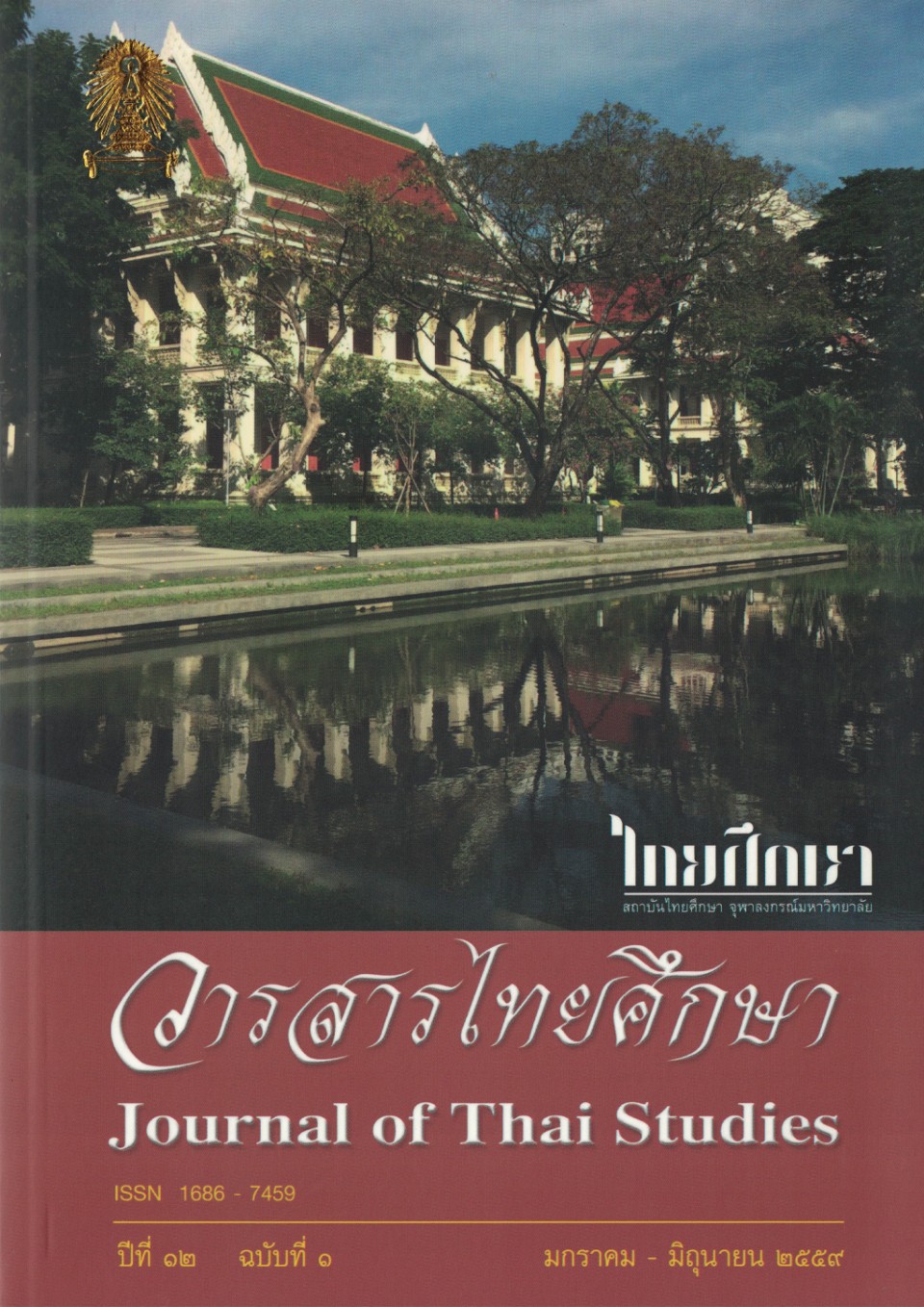An Analysis of Characterized Names of People in Chiang Rai
Main Article Content
Abstract
An analysis of characterized names of people in Chiang Rai aims at investigating the source of these names, how they were initiated, and the attitudes reflected from their characterized names in Tambon Tasud, Muang, Chiang Rai. The data was obtained from interviewing and questionnaires from respondents living in 11 villages, four respondents from each village, with the total number of respondents being 44. Each respondent gave 10 characterized names based on 13,421 villagers. The total number of characterized names was 440.
The results showed that the characterized names were derived from 7 reasons: physical appearance; behavior; careers; and metaphors; family background; nationality and religion; places; important events; and inflections. Physical appearance included shapes and body organs, with 172 characterized names found (39.10 %). Behaviors were classified into positive and negative behaviors, with 143 names found (32.50 %). Careers were classified into product names and job descriptions and metaphors, with 67 names found (15.22 %).
Family background was classified into intimates, relatives and nationality and religion, with 26 names found (5.90 %). Places were classified into location, geographical area, and originality, with 14 names found (3.18 %). Important events were classified into old names, and past events, with 11 names found (2.50 %). Lastly, inflections were classified into syllable inflection and word inflection which show no relationship with the person, but for transposition of the sounds and spoonerism, with seven names found (1.60 %).
The analysis from individual attitudes toward characterized names found that most characterized names were related to negative attitudes; approximately 287 characterized names (65.22 %) were derived from physical appearance, behaviors, important events, and language use. In addition, some characterized names were not related to any opinions; approximately 115 characterized names (26.13 %) were derived from careers, family background, places, language use and important events. Lastly, positive attitudes toward characterized names were found to be the least, with approximately 38 characterized names (8.63 %), and they were derived from behavior, physical appearance, and important events.
As for the use of language expressions, the characterized names both in standard Thai and northern Thai were literal meaning and figurative meaning of each character. The use of syllable, word or phrase may be different according to their circumstances or situations. Moreover, characterized names also reflect the social context and a culture of seniority in the family, family relations, personal roles in the community and diverse ethnicity.
Downloads
Article Details

This work is licensed under a Creative Commons Attribution-NonCommercial-NoDerivatives 4.0 International License.
Journal of Thai studies is licensed under a Creative Commons Attribution-Noncommercial-NoDerivatives4.0 Intenational (CC BY-NC-ND 4.0) licence, unless otherwise stated. Plese read our Policies page for more information on Open Access, copyright and permissions.
References
จรูญศรี มูลสวัสดิ์. การใช้ภาษาในการตั้งชื่อของชาวล้านนาในจังหวัดเชียงราย. วิทยานิพนธ์ปริญญาศิลปศาสตรมหาบัณฑิต สาขาวิชาภาษาศาสตร์ บัณฑิตวิทยาลัย มหาวิทยาลัยมหิดล, ๒๕๓๕.
เจือจันทน์ อิ่มสำราญ. วิเคราะห์การใช้ภาษาในการตั้งชื่อนักศึกษาชาย มหาวิทยาลัยศิลปากร วิทยาเขตพระราชวังสนามจันทร์. สารนิพนธ์ปริญญาอักษรศาสตรบัณฑิต สาขาวิชาภาษาไทย คณะอักษรศาสตร์ มหาวิทยาลัยศิลปากร, ๒๕๓๔.
ถวิล ธาราโภชน์. จิตวิทยาสังคม. พิมพ์ครั้งที่ ๒. กรุงเทพฯ : โอเดียนสโตร์, ๒๕๓๒.
เทศบาลตำบลท่าสุด. เข้าถึงจาก http://www.tasud.net/ml.php. เข้าถึงเมื่อ ๓ กรกฎาคม ๒๕๕๗.
นันทนา รณเกียรติ. “ลักษณะการตั้งชื่อเล่นในภาษาไทย” ภาษาและภาษาศาสตร์. ๖,๒ (มกราคม-มิถุนายน ๓๑) : ๕๐-๖๑.
เนตรทราย มณีโชติ. สมญานามในและรายการกีฬาทางสื่อมวลชน. ปริญญาอักษรศาสตรมหาบัณฑิต สาขาวิชาภาษาไทย คณะอักษรศาสตร์ จุฬาลงกรณ์มหาวิทยาลัย, ๒๕๔๔.
ราชบัณฑิตยสถาน. พจนานุกรมฉบับราชบัณฑิตยสถาน พ.ศ.๒๕๕๔. กรุงเทพฯ : ราชบัณฑิตยสถาน, ๒๕๕๖.
ลักษณา มณีโรจน์. วิเคราะห์การใช้ภาษาในการตั้งชื่อนักศึกษาหญิง คณะอักษรศาสตร์ มหาวิทยาลัยศิลปากร. สารนิพนธ์ปริญญาอักษรศาสตรบัณฑิต สาขาวิชาภาษาไทย คณะอักษรศาสตร์ มหาวิทยาลัยศิลปากร, ๒๕๓๔.
วิรัช ศิริวัฒนะนาคิน. การศึกษาการตั้งชื่อของคนไทย. วิทยานิพนธ์ปริญญาอักษรศาสตรมหาบัณฑิต สาขาวิชาภาษาไทย บัณฑิตวิทยาลัย มหาวิทยาลัยศิลปากร, ๒๕๔๔.
วิภัสรินทร์ ประพันธศิริ. คำเรียกญาติในภาษาคำเมือง การวิเคราะห์ทางอรรถศาสตร์ชาติพันธุ์. วิทยานิพนธ์ปริญญาอักษรศาสตรมหาบัณฑิต สาขาวิชาภาษาศาสตร์ ภาควิชาภาษาศาสตร์ คณะอักษรศาสตร์ จุฬาลงกรณ์มหาวิทยาลัย, ๒๕๓๕.
ศิริวรรณ เสรีรัตน์. พฤติกรรมผู้บริโภค. พิมพ์ครั้งที่ ๔. กรุงเทพฯ: พัฒนาศึกษา, ๒๕๓๘.
ศิวรี วรนิตินันท์. ตั้งชื่ออะไรดี. กรุงเทพฯ: ผดุงศึกษา, ๒๕๒๗.
ไศลรัตน์ อิสระเสนีย์. ความสัมพันธ์ระหว่างบุคคลในครอบครัวกับภาษาที่ใช้ในการตั้งชื่อจริง. วิทยานิพนธ์ปริญญาศิลปศาสตรมหาบัณฑิต สาขาวิชาภาษาศาสตร์ คณะศิลปศาสตร์ มหาวิทยาลัยธรรมศาสตร์, ๒๕๔๖.
สุภาพรรณ ณ บางช้าง. การใช้ภาษาในการตั้งชื่อของคนไทย. ฝ่ายวิจัย จุฬาลงกรณ์มหาวิทยาลัย, ๒๕๒๖.
โสภา ชูพิกุลชัย. จิตวิทยาสังคมประยุกต์. กรุงเทพฯ : ไทยวัฒนาพานิช, ๒๕๒๒.
โหราจารย์. หลักเกณฑ์การตั้งชื่อและกราฟทำนายชีวิต. กรุงเทพฯ: เสริมวิทย์บรรณาคาร, ๒๕๒๑.
อเนก สุวรรณบัณฑิต และ ภาสกร อดุลพัฒนากิจ. จิตวิทยาบริการ. กรุงเทพฯ: อดุลพัฒนกิจ, ๒๕๔๘.
อาภรณ์ คูประเสริฐวงศ์. วิเคราะห์การใช้ภาษาในการตั้งชื่อเล่นของคนไทยในปัจจุบัน. สารนิพนธ์ปริญญาอักษรศาสตรบัณฑิต สาขาวิชาภาษาไทย คณะอักษรศาสตร์ มหาวิทยาลัยศิลปากร, ๒๕๒๘.


